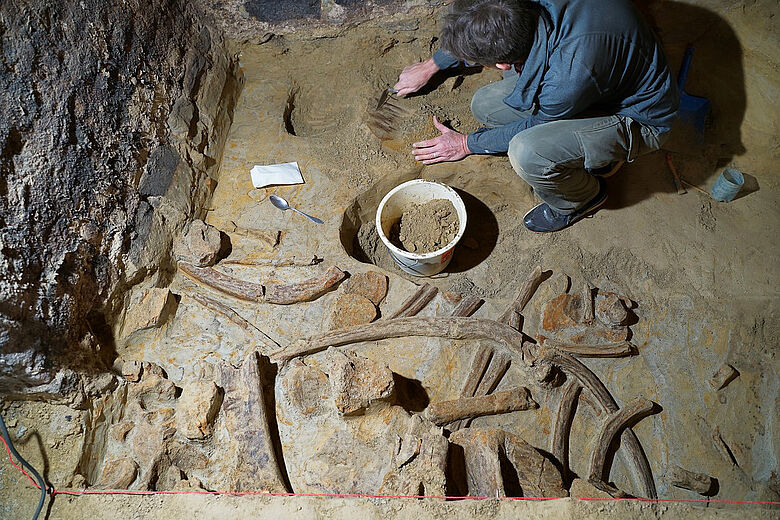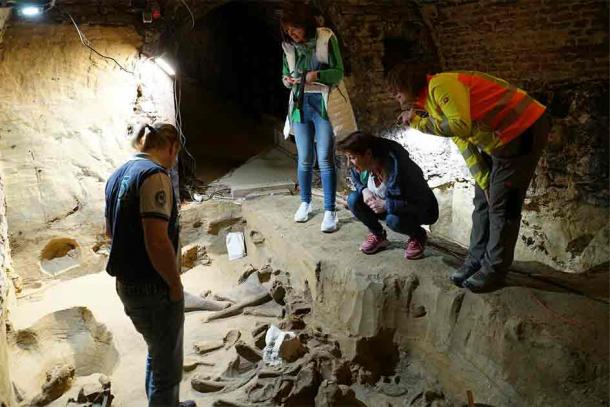Mammoth bones discovered in wine cellar in Austria

In a remarkable turn of events, a winemaker in Lower Austria has discovered mammoth bones dating back 30,000 to 40,000 years. This extraordinary discovery, made in a wine cellar in Gobelsburg, marks the most significant find of its kind in over a century, offering invaluable insights into the prehistoric era.
The discovery unfolded during a routine renovation of a wine cellar in the Krems region. The winemaker, Andreas Pernerstorfer, stumbled upon approximately 300 mammoth bones, prompting him to immediately report his findings to the Federal Monuments Office. Archaeologists from the Austrian Archaeological Institute of the Austrian Academy of Sciences (OeAW) were dispatched to investigate further.
Since mid-May, the OeAW team, led by archaeologists Thomas Einwögerer and Hannah Parow-Souchon, has been meticulously excavating the site. They have uncovered several layers of mammoth bones, along with stone artifacts and charcoal, suggesting the remains date back to the Upper Paleolithic period, between 30,000 and 40,000 years ago. The discovery site, now classified as a “significant bone site,” contains the remains of at least three mammoths.
Hannah Parow-Souchon, the lead excavator, emphasized the rarity and significance of such a dense mammoth bone layer. “It’s the first time that we’ve been able to investigate something like this in Austria using modern means,” she noted. The last comparable find in Austria occurred 150 years ago, also in the district of Krems, where a similar bone layer and cultural artifacts were uncovered in an adjacent cellar in Gobelsburg.

Parow-Souchon and her team believe they have found mostly complete mammoth skeletons, although the bones are not in anatomical connection. Among the rare finds is a lingual bone (tongue bone), which adds a unique element to the discovery. This significant haul prompts intriguing questions about the interactions between prehistoric humans and these massive creatures.
The excavation suggests that humans may have played a role in the mammoths’ demise. “We know that humans hunted mammoths, but we still know very little about how they did it,” Parow-Souchon explained. The location of the bones could indicate a hunting ground where Stone Age people possibly chased and trapped the mammoths. This hypothesis opens up new avenues for understanding the hunting strategies and survival tactics of early humans.
The bones are currently under examination by researchers and will eventually be transferred to the Natural History Museum Vienna for restoration and further study. The excavations and subsequent research have been funded by the Federal Monuments Office and the province of Lower Austria, underscoring the cultural and scientific importance of this find.
This discovery not only enriches our understanding of mammoth life and extinction but also sheds light on the relationship between prehistoric humans and their environment. The Gobelsburg site offers a unique snapshot of a time when mammoths roamed the European plains and early humans were mastering the art of survival.

As researchers continue to analyze the bones and artifacts, the findings from Gobelsburg are expected to contribute significantly to the field of archaeology and paleontology. The site could provide new insights into the migration patterns of mammoths, the climatic conditions of the era, and the adaptive strategies of Stone Age humans.
The unearthing of mammoth bones in a wine cellar in Lower Austria is a groundbreaking discovery that promises to deepen our understanding of prehistoric life. It highlights the dynamic interactions between early humans and their environment, offering a fascinating glimpse into a world long gone but not forgotten.






